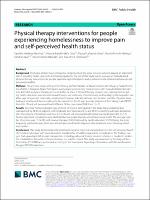Por favor, use este identificador para citar o enlazar este ítem:
https://repositorio.usj.es/handle/123456789/1158
| Título : | Physical therapy interventions for people experiencing homelessness to improve pain and self‑perceived health status |
| Autor: | Jiménez Sánchez, Carolina

Brandín de la Cruz, Natalia Lafuente Ureta, Raquel 
Francín Gallego, Marina 
Calvo Carrión, Sandra 

Fortún Rabadán, Rocío Pérez-Palomares, Sara 
|
| Fecha de publicación: | 9-abr-2024 |
| Editorial : | BMC |
| Citación : | Jiménez-Sánchez, C., la Cruz, N.Bd., Lafuente-Ureta, R. et al. Physical therapy interventions for people experiencing homelessness to improve pain and self-perceived health status. BMC Public Health 24, 993 (2024). https://doi.org/10.1186/s12889-024-18453-6 |
| Resumen : | Background Homeless shelters have emerged as components of the social services network, playing an important role in providing health care to the homeless population. The aim of this study was to evaluate an individualized physical therapy intervention for people experiencing homelessness and to determine the relationship between selfperceived variables. Methods Pre and post study, setting at the “Santa y Real Hermandad de Nuestra Señora del Refugio y Piedad” homeless shelter in Zaragoza, Spain. Participants were people experiencing homelessness with musculoskeletal disorders who attended a physical therapy service at shelter facilities. A physical therapy program was implemented including health education, exercise and manual therapy, electrotherapy, thermotherapy and bandaging. Demographic variables (age and gender), nationality, employment situation, educational level, pain location, number of painful areas, feeling of loneliness (3-Item Loneliness Scale; values from 3 to 9), pain intensity (Numerical Pain Rating Scale [NPRS]; from 0 to 10) and self-perceived health (Clinical Global Impression [CGI]; from 1 to 7). Results Sixty-four homeless people (age of 46.4 ± 10.9 years) participated in the study. Musculoskeletal pain was reported by 98.4% of subjects, with moderate pain intensities (6.1), and 48.4% presenting with pain at multiple sites. Perceptions of loneliness were low (3.7 ± 2.5) and self-perceived health status was moderately ill (3.5 ± 1.7). Positive significant correlations were identified between pain intensity and self-perceived health. The average number of sessions was 1.5 (± 0.8), with manual therapy (35.6%) followed by health education (23.5%) being the most frequently used techniques. Both pain and self-perceived health improved after treatment, even following a brief intervention. Conclusions This study demonstrates the potentially negative impact of untreated pain on the self-perceived health of homeless individuals with musculoskeletal disorders that should be targeted for consideration. The findings suggest that a paradigm shift in pain management, including a physical therapy service in shelters, is needed to address the rehabilitation demands of these individuals in a real-life context. This study was approved by the Aragon Ethics Committee (PI19/438) and performed according to the Transparent Reporting of Evaluations with Nonrandomized Designs (TREND) statement. |
| URI : | https://repositorio.usj.es/handle/123456789/1158 |
| ISSN : | 1471-2458 |
| Aparece en las colecciones: | Artículos de revistas |
Ficheros en este ítem:
| Fichero | Descripción | Tamaño | Formato | |
|---|---|---|---|---|
| Physical therapy interventions.pdf | 1,21 MB | Adobe PDF |  Visualizar/Abrir |
Este ítem está sujeto a una licencia Creative Commons Licencia Creative Commons

